Mental Health First Aid
Prevalence Statistics
Acknowledgement of Country
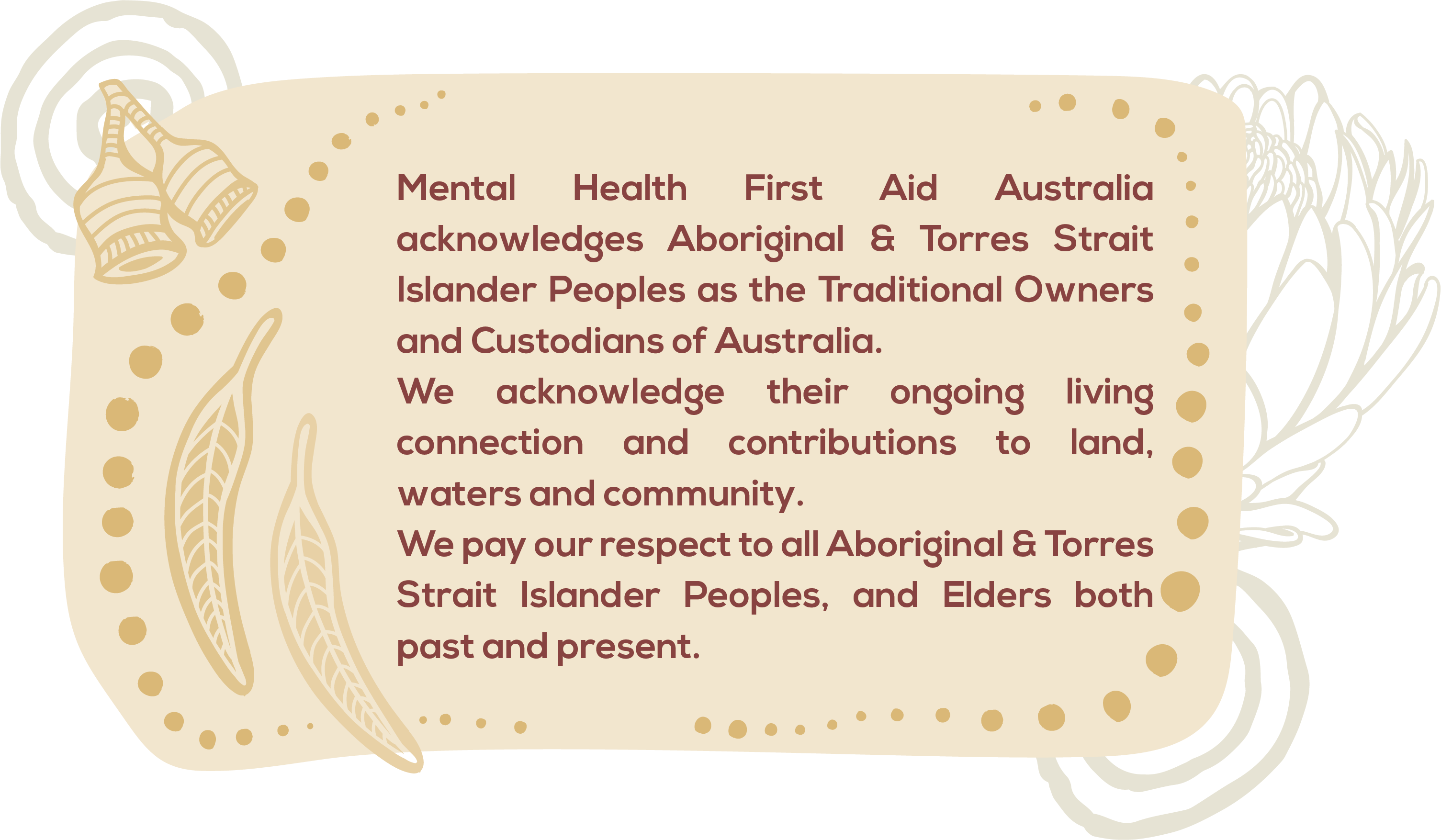
The following statistics are taken from Australian data. If you are interested in international mental health statistics, please visit: https://ourworldindata.org/mental-health
Adults
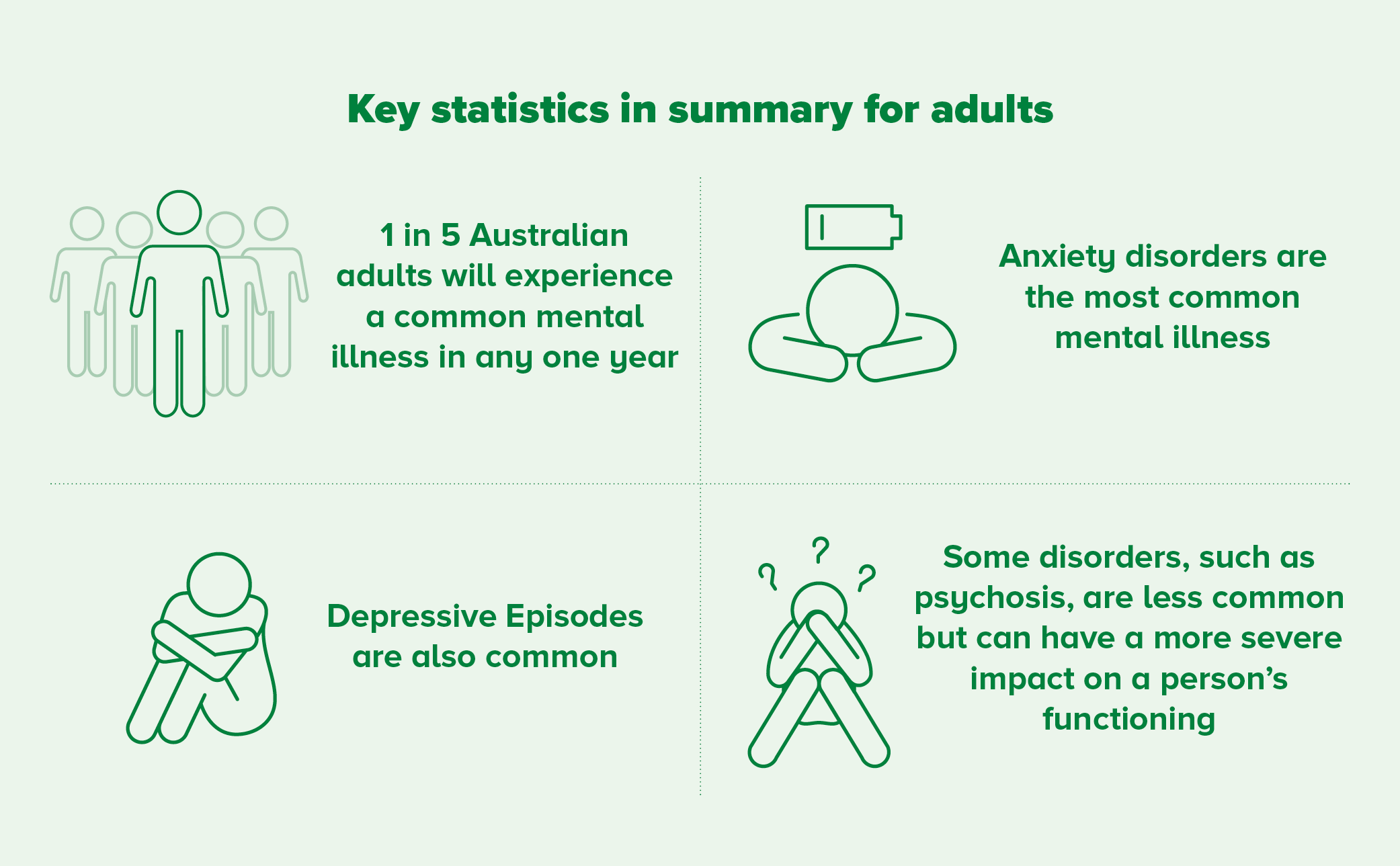
Statistics for adults focus on the adult population as a whole. These statistics do not necessarily accurately reflect the experiences in specific parts of the Australian community, such as particular age or cultural groups. Statistics for specific population groups are accessible from the menu at the top of the page.
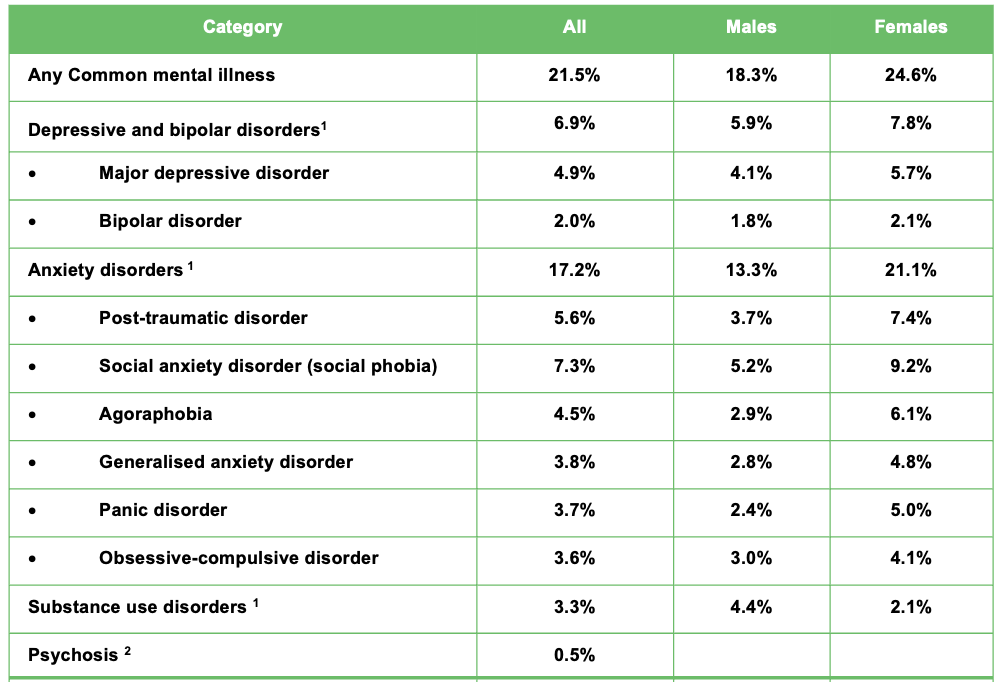
Additional Information and Source
1 National Survey of Mental Health and Wellbeing (2023). For further information, please visit the following website: https://www.abs.gov.au/statistics/health/mental-health/national-survey-mental-health-and-wellbeing-summary-results/latest-release
2 National Survey of Mental Health and Wellbeing (2009). For further information, please visit the following website: https://www.abs.gov.au/statistics/health/mental-health/national-study-mental-health-and-wellbeing/2007
Note: The mental health problems listed in this table are covered in Mental Health First Aid courses and have good quality data on their prevalence. Mental health problems not listed above are not covered in Mental Health First Aid courses or do not have enough good quality data to report. For further information on the quality of the data listed in the table, please refer to the methodology and limitations sections in the reports linked above.
Young Adults (16-24 years)
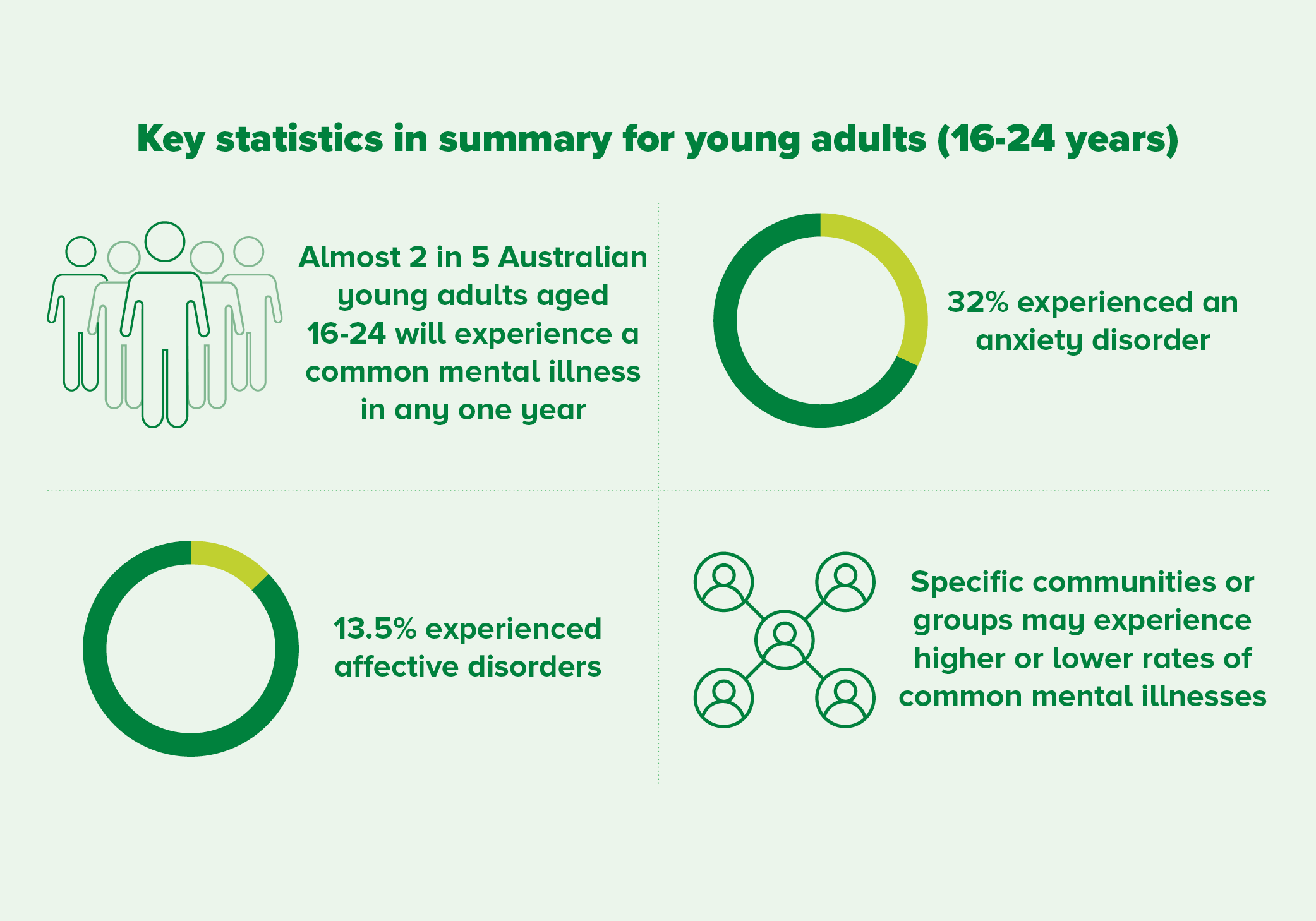

Additional Information and Source
Source: National Survey of Mental Health and Wellbeing (2023). For further information, please visit the following website: https://www.abs.gov.au/statistics/health/mental-health/national-survey-mental-health-and-wellbeing-summary-results/latest-release
Adolescents (12-17 years)

* Although ADHD and conduct disorder were included as mental disorders in this survey, they are currently not included in our Youth Mental Health First Aid course.
Additional Information and Source
Source: Australian Child and Adolescent Survey of Mental Health and Wellbeing (2015). For further information, please visit the following website: https://www.health.gov.au/resources/publications/the-mental-health-of-children-and-adolescents
Note: The mental health problems listed in these tables are covered in Mental Health First Aid courses and have good quality data on their prevalence. Mental health problems not listed above are not covered in Mental Health First Aid courses or do not have enough good quality data to report. For further information on the quality of the data listed in the table, please refer to the methodology and limitations sections in the reports linked above.
Older Adults

Additional Information and Source
Source: National Survey of Mental Health and Wellbeing (2023). For further information, please visit the following website: https://www.abs.gov.au/statistics/health/mental-health/national-survey-mental-health-and-wellbeing-summary-results/latest-release
Note: The mental health problems listed in this table are covered in Mental Health First Aid courses and have good quality data on their prevalence. Mental health problems not listed above are not covered in Mental Health First Aid courses or do not have enough good quality data to report. For further information on the quality of the data listed in the table, please refer to the methodology and limitations sections in the reports linked above
Aboriginal and Torres Strait Islander Peoples
Notes on the data
- There are many areas where there is a lack of good information about mental illness for Aboriginal and Torres Strait Islander Peoples. Areas include non-suicidal self-injury, eating disorders, gambling, psychosis, some anxiety disorders, and help-seeking data.
- It should be noted that the data presented in this section comes from a single survey, which is not as comprehensive as the broader Australian data presented in previous sections.
- Even when there is information on Aboriginal and Torres Strait Islander Peoples, the data can be of varying quality. For example, a study might report on only a small sample of Aboriginal and Torres Strait Islander Peoples, or might rely on self-reported data.
- It should also be noted that the prevalence rates and experiences in Aboriginal and Torres Strait Islander communities can vary significantly, and that the statistics presented here are national averages. The data may not fully represent the experiences of specific groups, such as Aboriginal and Torres Strait Islander Peoples living in remote communities.
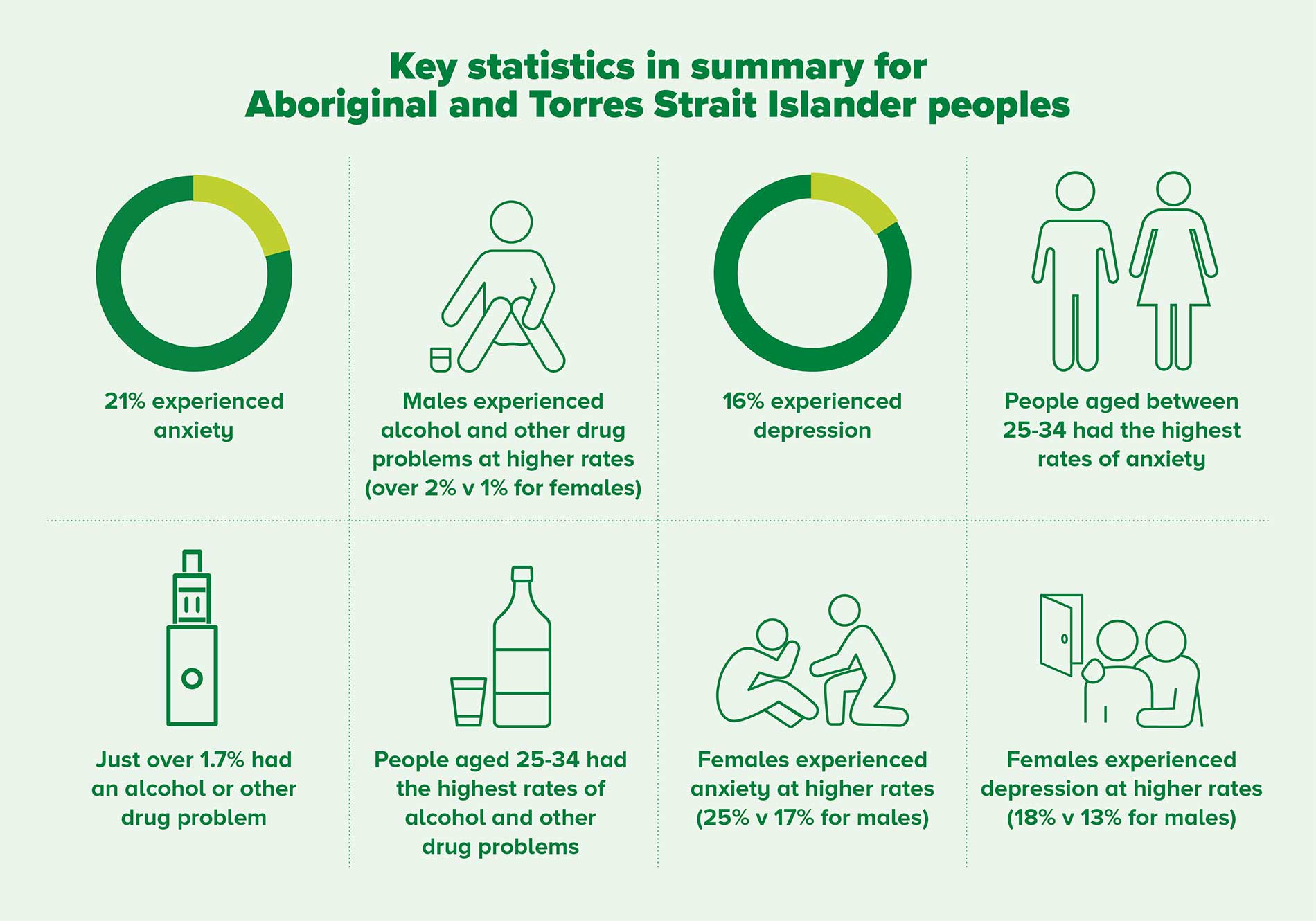
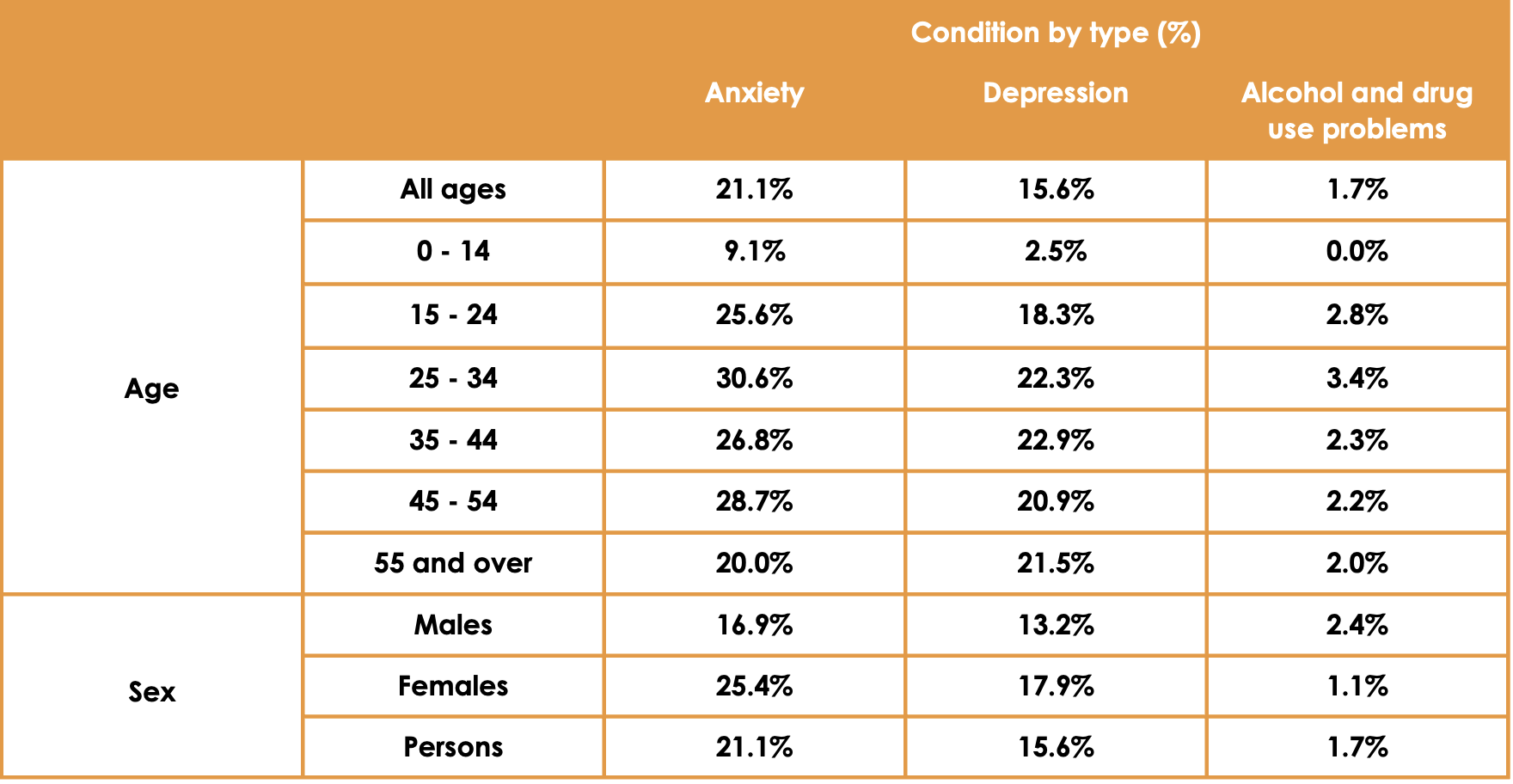
Additional Information and Source
Additional Information and Source
Australian Bureau of Statistics. (2022-23). National Aboriginal and Torres Strait Islander Health Survey. ABS. https://www.abs.gov.au/statistics/people/aboriginal-and-torres-strait-islander-peoples/national-aboriginal-and-torres-strait-islander-health-survey/latest-release.
Additional resources
Source: Australia Institute of Health and Welfare: Indigenous Mental Health and Suicide Prevention Clearinghouse: Mental Health 2018-19 (updated 2024) https://www.indigenousmhspc.gov.au/topics/mental-health#aboutthistopic
Australian Bureau of Statistics: Intentional self-harm deaths (Suicide) of Aboriginal and Torres Strait Islander people (2023) https://www.abs.gov.au/statistics/health/causes-death/causes-death-australia/latest-release#intentional-self-harm-deaths-suicide-of-aboriginal-and-torres-strait-islander-people
Aboriginal and Torres Strait Islander Health Performance Framework Summary Report (2024) https://www.indigenoushpf.gov.au/Report-overview/Overview/Summary-Report
Australian Institute of Health and Welfare National Drug Strategy Household Survey 2022-2023 (2024) https://www.aihw.gov.au/reports/illicit-use-of-drugs/national-drug-strategy-household-survey
Australian Burden of Disease Study: impact and causes of illness and death in Aboriginal and Torres Strait Islander people 2018 (published 2022) https://www.aihw.gov.au/reports/burden-of-disease/illness-death-indigenous-2018/summary
Australian Institute of Health and Welfare: Measuring the social and emotional wellbeing of Aboriginal and Torres Strait Islander peoples (2009) https://www.aihw.gov.au/reports/indigenous-australians/measuring-the-social-and-emotional-wellbeing/contents/table-of-contents
LGBTIQ+ Adults
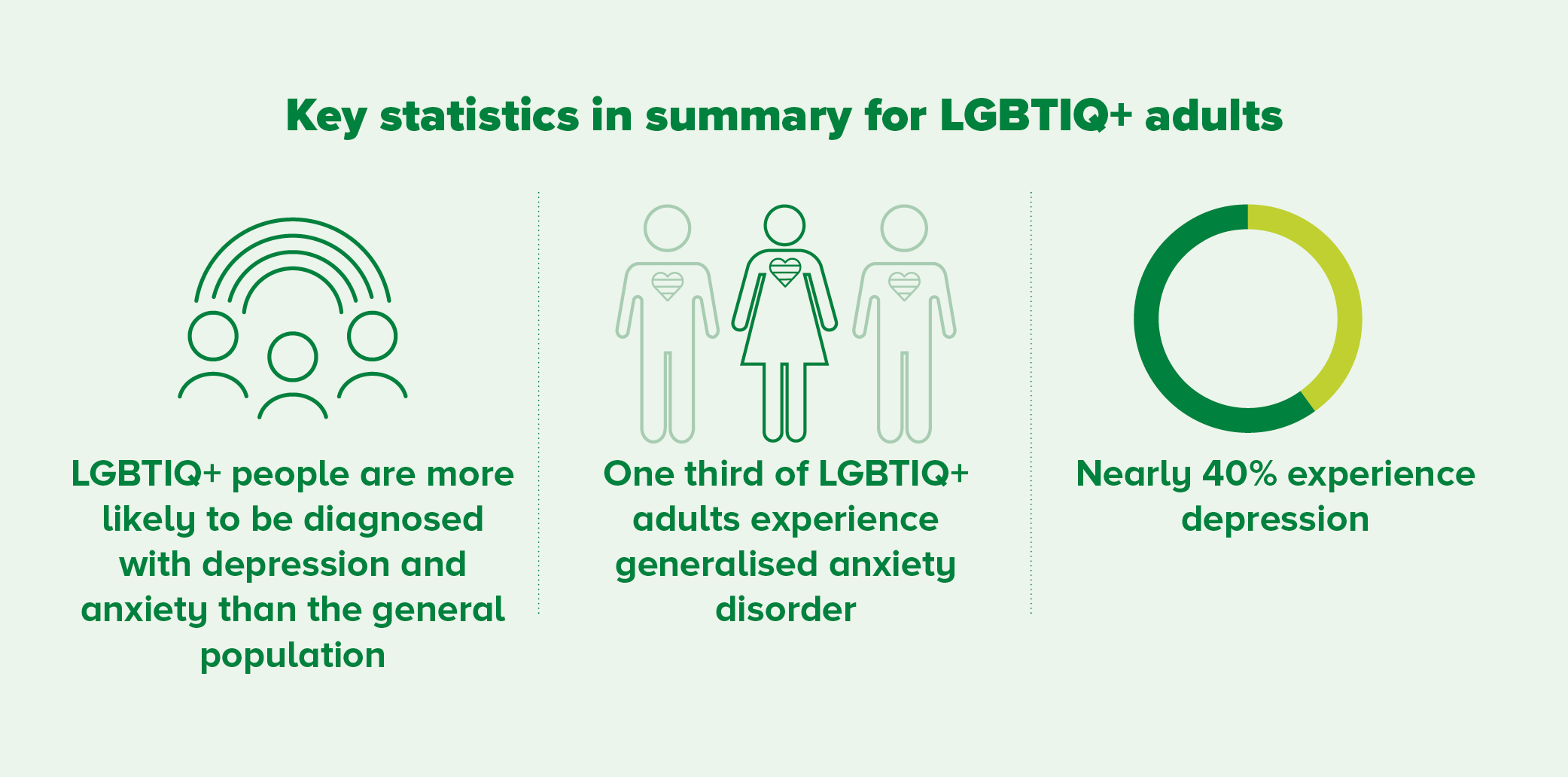
Additional Information and Source
Source: Private Lives 3: The Health and Wellbeing of LGBTIQ People in Australia (2020). For further information, please visit the following website: https://www.latrobe.edu.au/arcshs/work/private-lives-3
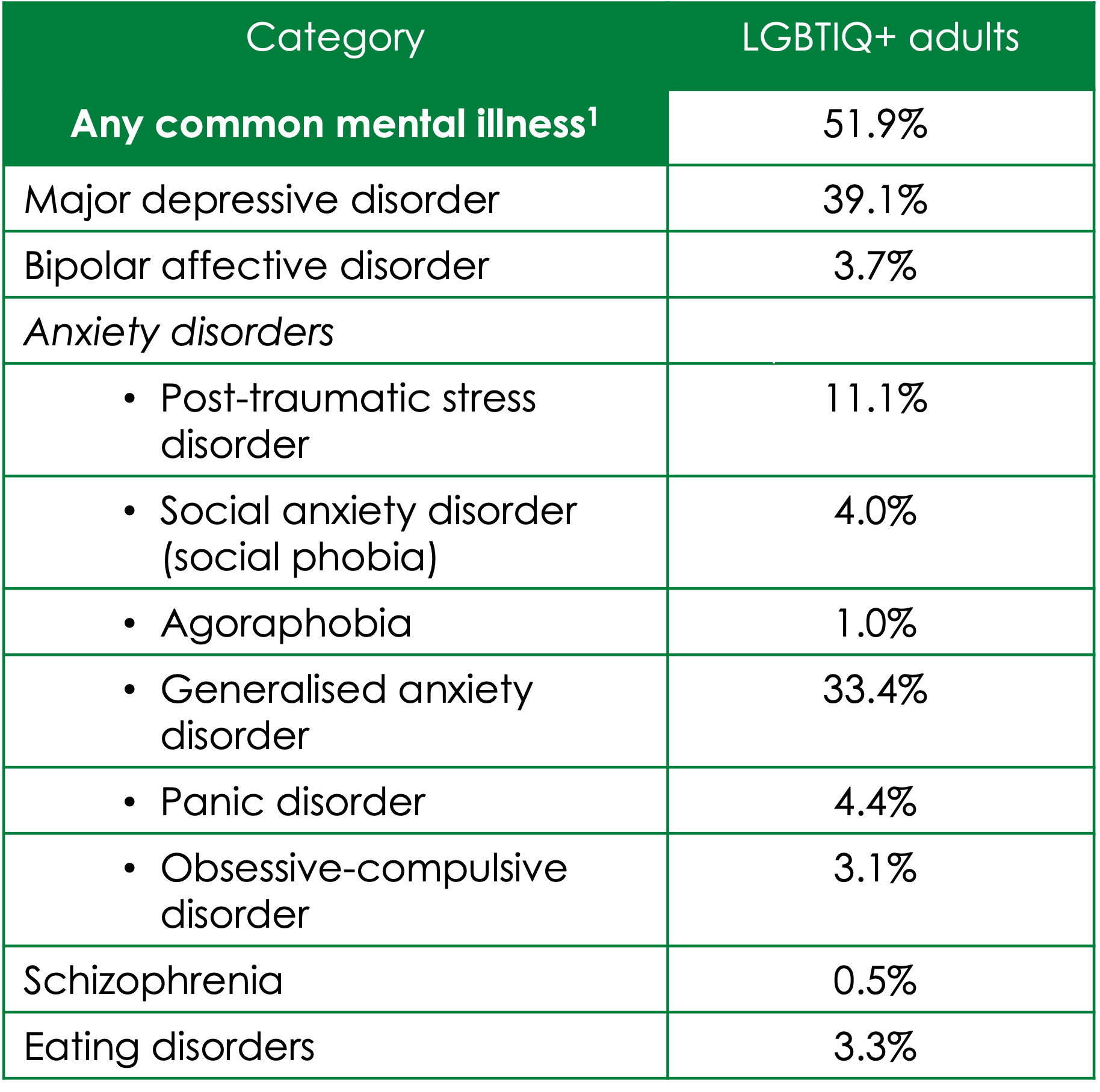
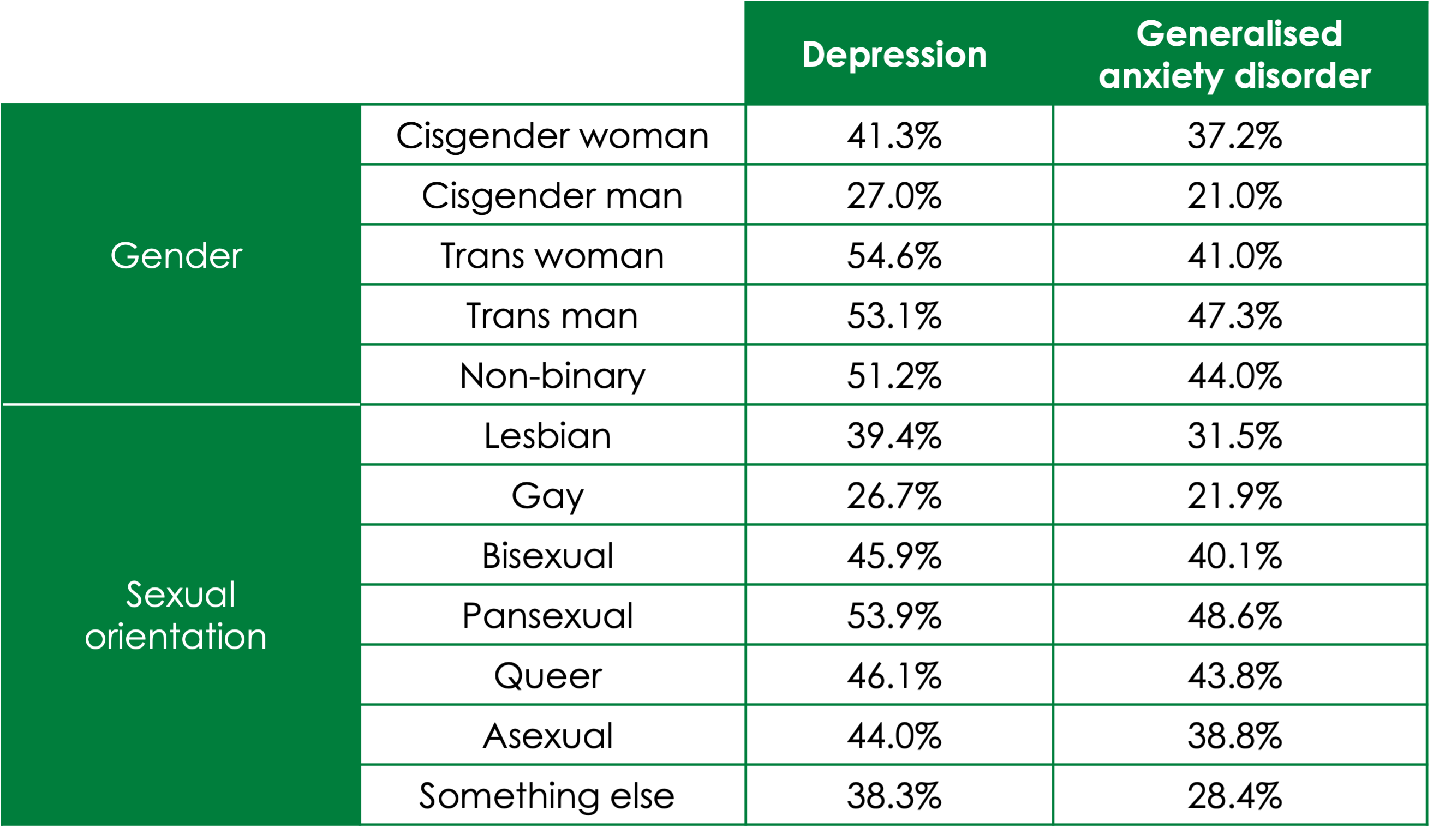
Additional Information and Source
Additional Information and Source
Source: Private Lives 3: The Health and Wellbeing of LGBTIQ People in Australia (2020). For further information, please visit the following website: https://www.latrobe.edu.au/arcshs/work/private-lives-3
Additional information: Further information on the mental health of LGBTQA+ young people (aged 14-21) in Australia can be found in the Writing Themselves In 4 report (2021): https://www.latrobe.edu.au/arcshs/work/writing-themselves-in-4
Note: The mental health problems listed in these tables are covered in Mental Health First Aid courses and have good quality data on their prevalence. Mental health problems not listed above are not covered in Mental Health First Aid courses or do not have enough good quality data to report.
It should be noted that although the reports listed above contain the best quality data currently available on this population in Australia, they contain limited information on the methodology and limitations of the research. Some possible limitations of the research include:
- The use of convenience sampling to recruit participants, i.e., the sample population is not random and therefore may not be representative of all LGBTIQ+ people.
- Relied on participant self-reports of mental illness
- Although the paper was published in 2020, it should be noted that the data was collected before COVID-19 lockdowns.
Glossary of Terms
Agoraphobia
Agoraphobia is a type of anxiety disorder that occurs when someone avoids situations where they are afraid a panic attack might happen. They worry that if a panic attack occurs it will be difficult or embarrassing to get away from the place, or that there will be no one around who can help. Some people may avoid only a few situations or places, for example crowds or enclosed places such as shopping centres. Others may avoid leaving their house altogether.
Anorexia nervosa
Anorexia nervosa is a type of eating disorder, characterised by the use of extreme weight-loss strategies (such as dieting, fasting, vomiting, or over-exercising) in an attempt to control body weight. A person with anorexia nervosa often focuses on body shape and weight as a measure of self-worth. This is often associated with an intense fear of gaining weight or becoming fat, even if they are underweight.
Binge eating disorder
Binge eating disorder occurs when a person has recurrent episodes of eating an unusually large amount of food in a short period of time, and continues to eat beyond the point of feeling comfortably full. These binges occur at least once per week over 3 months or more.
Bipolar affective disorder
Bipolar disorder is a type of mood disorder that can also involve psychosis. A person with bipolar disorder will experience extreme mood swings. These mood swings involve switching between periods of depression, periods of mania and periods of normal mood. Bipolar mood swings are different to general moodiness which may cause a person to switch feelings on a daily basis, or several times a day. Sometimes people with bipolar also experience psychosis as part of their depression or mania.
Bulimia nervosa
Bulimia nervosa involves recurrent and frequent episodes of eating unusually large amounts of food while feeling a lack of control over their eating, followed by any behaviour that compensates for the binge, such as purging, fasting, or excessive exercising. A person with bulimia can be slightly underweight, overweight, or fall within the healthy weight range.
Depression (also known as Major Depressive Disorder)
Depression is when someone has a low or irritable mood, loses interest or enjoyment in activities they normally like, or has a lack of energy or is overcome with tiredness. Depression is a mood disorder because it affects the way people feel (their mood). To be diagnosed with clinical depression or major depression, a person must have had some symptoms for at least two weeks, and their ability to carry out their work or usual daily activities, or their ability to have satisfying personal relationships, is being affected by their low mood.
Eating disorders
Eating disorders are mental and physical illnesses where food, weight, and body shape concerns become the unhealthy focus of a person’s thinking, usually as a way to manage underlying psychological issues. There is an overvaluation of the importance of body shape and weight, and a distorted self-image.
Generalised anxiety disorder
Generalised anxiety disorder (GAD) occurs when someone experiences long term anxiety across a whole range of situations and this interferes with their life. GAD is an overwhelming, unfounded anxiety and worry about things that may go wrong or one’s inability to cope, together with many physical and psychological symptoms of anxiety.
Obsessive-compulsive disorder (OCD)
Obsessive-compulsive disorder (OCD) is an uncommon but very disabling type of anxiety disorder. A person with OCD will experience obsessive thoughts, which are repeated thoughts or urges that the person cannot get out of their head and which cause them distress. Compulsive behaviours are performed by people with OCD, in response to the obsessive thoughts, in order to reduce the anxiety they cause. For example, a person may be repeatedly worried about dirt and germs and may wash their hands over and over.
Panic disorder
Panic disorder occurs when someone experiences panic attacks and for at least one month is constantly worried about possible future panic attacks and the possible consequences of panic attacks (such as a fear of losing control or having a heart attack).
Psychosis
Psychosis is a mental illness in which a person has lost some contact with reality. Psychosis alters a person’s ability to know what is real from what is not real and causes severe disturbances in thinking, feeling, communication and behaviour. Psychosis can severely disrupt a person’s life.
Post-traumatic stress disorder (PTSD)
Post-traumatic stress disorder (PTSD) is a severe form of anxiety disorder that can develop after a traumatic event. Someone with PTSD will re-experience the original traumatic event(s) through flashbacks or nightmares, will avoid objects or situations that remind them of the traumatic event, and will experience increased arousal (such as difficulty falling or staying asleep, anger, or feel constantly highly-strung or on edge). Many people who experience a traumatic event become distressed immediately afterwards, but most do not go on to develop PTSD.
Schizophrenia
Schizophrenia is a severe but uncommon form of psychotic disorder, in which someone loses touch with reality. Someone with schizophrenia will experience delusions and hallucinations, thinking difficulties, loss of drive or lack of motivation, blunted or inappropriate emotions and social withdrawal.
Social anxiety disorder (also known as social phobia)
Social phobia occurs when someone avoids social situations because of a fear that they will be negatively judged by others. People with social phobia often fear behaving in a way that is embarrassing or humiliating.
Substance use disorders
Substance use disorders occur when people become hooked on alcohol or another drug (substances), or they use alcohol or another drug in a way that leads to problems at work, school or in the home, family or community. It also means that a person uses alcohol or drugs at a level that causes damage to their health.
